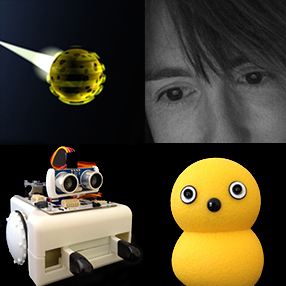Baxter is a new workplace robot developed by a company called Rethink Robotics, run by Rodney Brooks (a very well known robot designer, who also started the company iRobot famous for developing Roomba robotic vacuum cleaners). Baxter is designed to work next to people in manufacturing environments, being human-like in form and consisting of a torso and two arms, together with a screen “face” (well, one consisting of eyes and eyebrows at least).
Most interesting to me is the way in which people communicate with Baxter, using touch first to get the robot’s attention and then to move the robot’s arms into particular positions. This reminds me of the touch of a yoga teacher, for example, in helping to position people into a particular pose. Baxter also has a graphical interface, displayed on the same screen that more often shows the robots eyes, which is controlled with buttons on each arm. In order to “program” Baxter to complete a task a person can therefore show the robot what to do by moving its arms into position and choosing the appropriate action, eg to pick up or place down a part, from the user interface. Importantly, it is the way in which Baxter learns a movement from being placed into position that seems to separate it from various other manufacturing robots currently in production.
As Rodney Brooks explains in the interview with IEEE Spectrum writers Erico Guizzo and Evan Ackerman, “[w]hen you hold the cuff, the robot goes into gravity-compensation, zero-force mode” such that “the arm is essentially floating”. This makes the robot easy to position, and as Mike Bugda notes in the video below, Baxter is therefore understood to be “very compliant to the user”. Although “compliant” is used here in part to emphasise that the robot is flexible and therefore able to deal with “an unstructured environment” (Matthew Williamson, in conversation with Guizzo and Ackerman), there is also a sense in which this robot is being placed as a servant, or possibly even a slave, by virtue of its immediate compliance to a human’s touch. This design decision in itself is probably a pragmatic response to making the robot easy to program in the workplace, but from my perspective it raises some issues since this is also clearly a robot designed to be read as human-like, but also as a compliant servant/slave.
The idea of Baxter as human-like is reinforced when Bugda (in the video below) explains that Baxter “exhibits a certain level of interaction, collaborative friendliness that makes it easy to understand and introduce into a manufacturing environment”. For example, when you touch its arm the robot stops what it is doing and looks towards you, acknowledging your presence, and once its instruction is complete the robot acknowledges that it understands with a nod of its “head”. Guizzo and Ackerman take this idea further, when they suggest that while at work Baxter’s “animated face” displays “an expression of quiet concentration”, while a touch on the arm causes Baxter to “stop whatever it’s doing and look at you with the calm, confident eyes”.
Although this video is simply a demonstration, Baxter has obviously had some limited field testing, and Brooks (again in conversations with Guizzo and Ackerman) notes that after people have worked with the robot for a while “something interesting happens … People sort of personify the robot. They say, ‘It’s my buddy!’”. It is at this point that the perception of the robot as a friend is reinforced.
This type of reading of Baxter as a “buddy” or friend might be assumed to be closely linked to the robot’s human-like form. However, my research considering the ALAVs, the Fish-Bird project and also Guy Hoffman’s robotic desk lamp, AUR, along with anecdotal evidence from friends who are owners of Roomba robotic vacuum cleaners, indicates that robots of pretty much any form encourage this kind of personification. In addition, for Baxter, I suspect that the use of touch between human and robot might also serve to support the perception of this robot as a social subject, and eventually a friend. The importance of touch in working with Baxter would seem to sets this robot apart from others that I have considered in my research to date. This might also suggest that Baxter could be made more machine-like (and less human-like) in a move that would reduce my discomfort in placing humanoid robots as servants/slaves, as I have suggested occurs with this robot worker.

